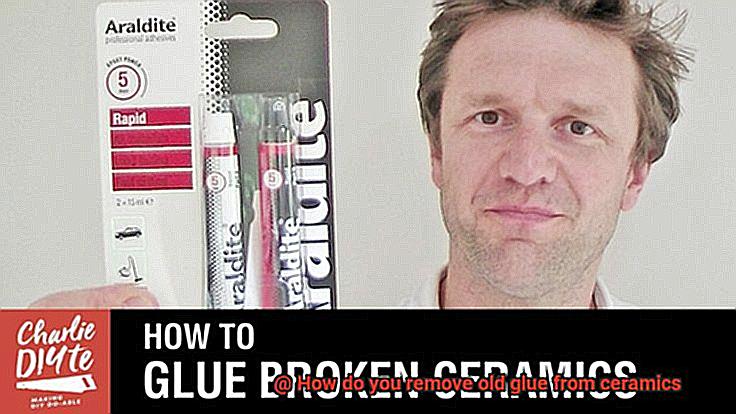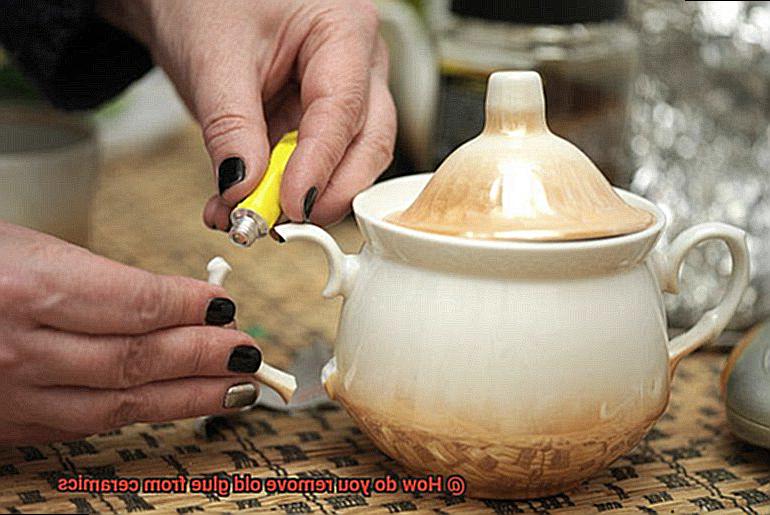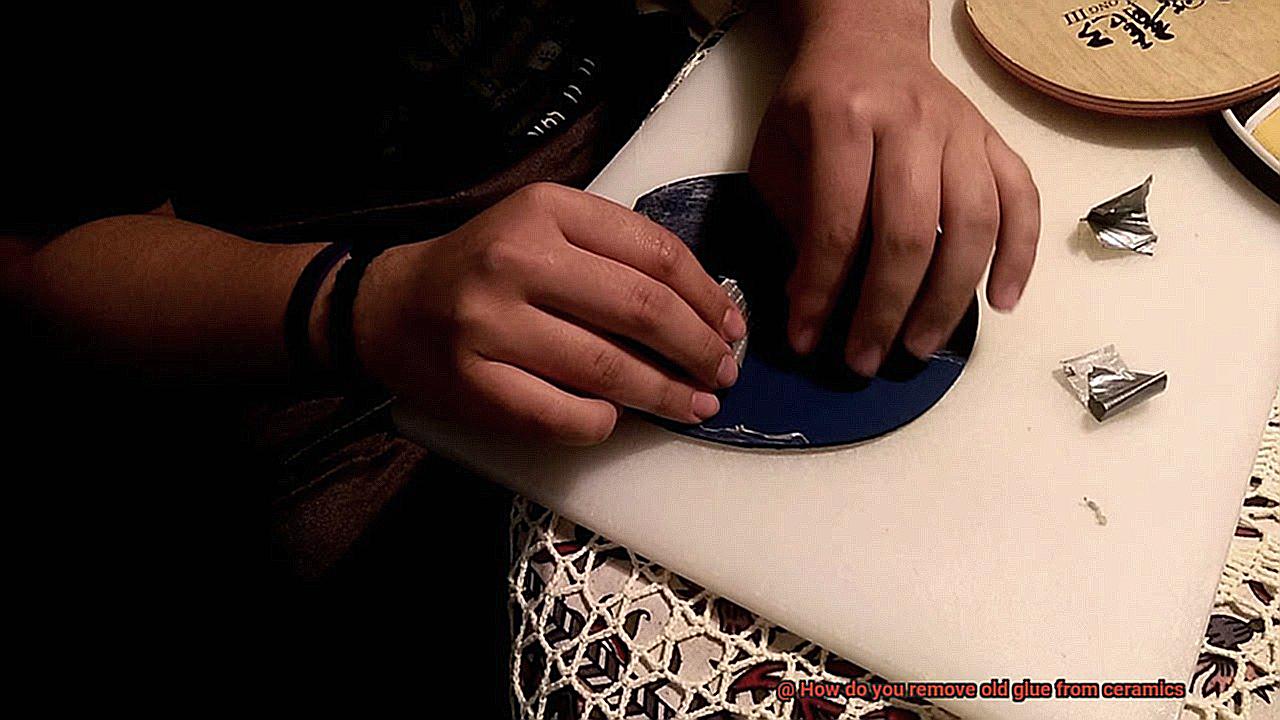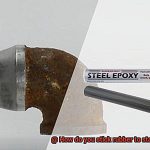Get ready to embark on a journey that will revolutionize your restoration game. Whether you’re a die-hard collector, a DIY addict, or just someone who appreciates the beauty of ceramics, I’ve got some exciting news for you. Today, we’re going to tackle the dreaded nemesis that haunts our precious ceramic treasures – old glue residue.
Picture this: you’re admiring your favorite ceramic piece when suddenly, you spot those ugly remnants of past repairs. Ugh. But fear not. I’m here to spill all the secrets on how to banish that stubborn glue and bring your ceramics back to their former glory.
In this ultimate guide, we’ll dive deep into the art and science of removing old glue like pros. We’ll uncover the different types of glue you might encounter and explore safe and efficient removal methods. So grab your sleeves and let’s get down and dirty together.
But why is it so important to bid farewell to that pesky old glue? Well, aside from ruining the aesthetics of our beloved ceramics, it can actually weaken their structure. Plus, future repairs or touch-ups become mission impossible without a clean surface. It’s time to say goodbye to those remnants of the past and restore our ceramics to their pristine state.
So without further ado, let’s dive headfirst into the captivating world of ceramic restoration. Together, we’ll unlock the secrets behind this thrilling craft and revel in the satisfaction of breathing new life into our cherished ceramic heirlooms. Are you ready? Let’s do this.
What is Glue and Why is it Used on Ceramics?
Contents
- 1 What is Glue and Why is it Used on Ceramics?
- 2 Heat Method for Removing Glue from Ceramics
- 3 Acetone Method for Removing Glue from Ceramics
- 4 Vinegar Method for Removing Glue from Ceramics
- 5 Commercial Adhesive Removers for Removing Glue from Ceramics
- 6 Tips and Precautions When Using Any of the Above Methods
- 7 Conclusion
Glue, also known as adhesive, is a remarkable substance that serves as a bonding agent for various materials. It possesses strong adhesive properties, making it a popular choice across industries and applications. In the realm of ceramics, glue plays a crucial role in repairing broken pieces and reuniting them.
Ceramics, delicate and fragile by nature, are susceptible to breakage, especially when mishandled or accidentally dropped. This is where glue emerges as a savior, offering a convenient solution for fixing these shattered fragments and restoring the overall integrity of the ceramic object. By creating a robust and enduring bond, glue ensures that the broken pieces stay firmly in place even when subjected to stress or strain.
One of the noteworthy advantages of using glue on ceramics stems from its versatility in application. It can be effectively employed on different ceramic surfaces, including both glazed and unglazed areas. This flexibility renders it suitable for repairing an extensive range of ceramics, be it exquisite decorative figurines or utilitarian items like mugs or plates.
Another remarkable attribute of glue lies in its ability to fill gaps and cracks with ease. When a ceramic object fractures, small gaps or cracks typically appear between the broken pieces. Glue possesses the remarkable capability to infiltrate these spaces, creating a strong bond that effectively fills the voids. Consequently, this not only enhances the overall appearance of the repaired ceramic but also fortifies its structural integrity.
Furthermore, employing glue on ceramics offers an efficient and cost-effective solution for restoration. Instead of discarding a broken ceramic object and purchasing a new replacement, glue allows for easy repairs at merely a fraction of the cost. This sustainability-focused approach appeals to individuals who seek to prolong the lifespan of their cherished ceramics while minimizing waste.
Heat Method for Removing Glue from Ceramics
Removing old glue from ceramics can be a challenging task, but the heat method provides a reliable solution. This method works by softening the glue, making it easier to remove without damaging the ceramic surface. Here’s how you can effectively use the heat method:
- Hairdryer: Begin by using a hairdryer on its highest setting. Hold it about 6 inches away from the surface and move it in a circular motion to evenly distribute the heat. As the glue heats up, it will start to melt and become more pliable.
- Plastic scraper or fingernail: Once the glue has softened, gently peel it off the ceramic surface using a plastic scraper or your fingernail. Take care not to apply too much pressure to avoid scratching or damaging the ceramic.
- Heat gun: If the glue proves stubborn, try using a heat gun instead of a hairdryer. A heat gun provides more concentrated and intense heat that can loosen even the toughest glue. However, exercise caution when using a heat gun as it can generate high temperatures that may cause burns or damage to the ceramic. Always follow the manufacturer’s instructions and wear protective gloves.
- Hot water bath: Another option is immersing the ceramic object in hot water. Fill a basin or sink with hot water and submerge the glue-covered area. Allow it to soak for 20-30 minutes or until you notice the glue has softened.
- Scrub and rinse: After the glue has softened, gently scrub away any residue using a soft cloth or sponge. For stubborn spots, use a plastic scraper or an old toothbrush. Finally, rinse the ceramic thoroughly with warm water to remove any remaining glue residue.
Remember that while the heat method is effective for most glues, some adhesives may be more resistant to heat. In such cases, consider alternative methods or seek professional assistance.
Acetone Method for Removing Glue from Ceramics
The Acetone Method for Removing Glue from Ceramics is a powerful technique that can effectively break down glue bonds and restore the beauty of your ceramics. Acetone, a common solvent with strong dissolving properties, is the key ingredient in this method.

Before you start, ensure your safety by working in a well-ventilated area to avoid inhaling the potentially harmful fumes. Keep acetone away from open flames or sparks, as it can be flammable. It’s also wise to wear gloves to protect your hands during the process.
To begin, test the acetone on a small, inconspicuous spot of the ceramic surface. This step ensures that the acetone doesn’t cause any damage or discoloration to your precious ceramics.
Once you’ve confirmed its compatibility, apply a small amount of acetone directly onto the glued area. Allow it to sit for a few minutes, giving it time to penetrate and dissolve the glue.
Now it’s time to gently scrub the area using a clean cloth or sponge. Employ circular motions as you scrub, and watch as the dissolved glue particles start coming off the surface of the ceramic.
If there are still traces of glue remaining, don’t fret. Simply reapply acetone and continue scrubbing until all the glue is removed. Patience is key here; avoid using excessive force that could potentially damage the ceramic.

After successfully removing all traces of glue, rinse the ceramic thoroughly with water to ensure all remnants of acetone are gone. Dry it with a clean cloth before proceeding.
Once dry, take a moment to clean and admire your newly restored ceramic piece. With the acetone method, you can say goodbye to that pesky glue and enjoy your beautiful ceramics once again.
Remember, different ceramics may react differently to acetone, so always test it first. And don’t forget about safety precautions. Working in a well-ventilated area and wearing gloves will ensure a successful and safe glue removal process.
Vinegar Method for Removing Glue from Ceramics
Removing glue from ceramics can be a frustrating task, but fear not, because vinegar is here to save the day. Vinegar is a versatile household product that can be used for various cleaning purposes, and its acetic acid content makes it a powerful adhesive dissolver. So, let’s dive into the vinegar method for removing glue from ceramics.
First, prepare the solution. In a bowl or container, mix equal parts vinegar and warm water. This creates a gentle yet effective solution for breaking down the glue.
Next, soak the ceramic object. Submerge the affected area in the vinegar solution and let it soak for about 10-15 minutes. This allows the acetic acid to work its magic and dissolve the glue.
After soaking, it’s time to gently scrub. Take a soft brush or sponge and gently scrub the area to help loosen the glue. Be careful not to scrub too hard and damage the ceramic surface.
If the glue is being stubborn and doesn’t come off easily, you can use a plastic scraper or a credit card to carefully scrape away the softened glue. Take your time and be cautious not to scratch or damage the ceramic.
Once you’ve removed the majority of the glue, rinse the ceramic object with clean water to remove any vinegar residue. Finally, dry it thoroughly with a clean towel or allow it to air dry before using or storing it.
Commercial Adhesive Removers for Removing Glue from Ceramics
Commercial adhesive removers offer a convenient and effective solution for removing stubborn glue from ceramics. These specially formulated products are designed to break down the adhesive bond, making it easier to separate the glue from the ceramic surface. Let’s explore the different types of commercial adhesive removers available and how to use them properly.
One popular type of commercial adhesive remover is solvent-based. These powerful removers use chemicals to dissolve the glue, making them highly effective against a wide range of adhesive types. They work quickly and require less physical effort compared to other methods.
However, it’s important to note that some solvent-based removers may contain harsh chemicals, so it’s crucial to follow the manufacturer’s instructions carefully and work in a well-ventilated area.
To use a solvent-based remover, simply apply it to the glue and let it sit for a few minutes to allow the solvent to penetrate the adhesive. Gently scrub the area with a soft cloth or sponge until the glue starts to loosen, then rinse with water to remove any residue.
Another type of commercial adhesive remover is citrus-based. These natural alternatives use citrus extracts to break down and dissolve the glue. They are generally safer and more environmentally friendly than solvent-based removers, making them a preferred choice for individuals who prefer using natural products. To use a citrus-based remover, apply it directly onto the glue and let it sit for a few minutes. Then, gently scrub the area with a soft cloth or sponge until the glue starts to loosen. Rinse with water afterward to ensure all residue is removed.
It’s essential to remember that not all commercial adhesive removers are suitable for all types of glues or ceramics. Before using any remover, it’s recommended to test it on a small, inconspicuous area of the ceramic surface to ensure compatibility. Additionally, if you prefer not to use chemical-based products, there are alternative methods available. Applying heat from a hairdryer or heat gun can soften the adhesive, making it easier to remove with a plastic scraper or credit card. Gentle abrasives like fine sandpaper or abrasive cleaners can also be used, being careful not to scratch or damage the ceramic.
Tips and Precautions When Using Any of the Above Methods
When removing old glue from ceramics, it is important to take certain precautions to ensure safety and protect the ceramic surface. This article provides valuable tips and precautions to follow when using various methods like heat, solvents, vinegar, or commercial adhesive removers. By following these guidelines, you can effectively remove old glue without causing any harm or damage to the ceramic.
Test on a small area:
Before applying any method to the entire surface, it is crucial to test it on a small, inconspicuous area of the ceramic. This helps determine its effectiveness without causing harm or discoloration. Apply a small amount of the chosen method and observe for any adverse reactions for at least 24 hours. If there is no negative impact, proceed with confidence.
Use protective gear:
Wear protective gloves and goggles when working with chemical-based solutions or abrasive materials. This shields your skin and eyes from potential irritation or harm. The gloves protect your hands from chemicals or abrasive substances, while goggles prevent any splashes or fumes from entering your eyes.
Work in a well-ventilated area:

When using chemical solvents like acetone or nail polish remover, ensure proper ventilation by opening windows or using fans. This prevents prolonged exposure to harmful fumes. The fumes emitted by these solvents can be strong and irritating, so it is crucial to have fresh air circulating to avoid any respiratory discomfort.
Maintain safe distance and keep the heat source moving:
If using heat-based methods such as a hairdryer or heat gun, avoid placing them too close to the ceramic surface. Excessive heat can cause cracks or breakage. Keep the heat source moving constantly and avoid focusing it on one spot for too long. This ensures that the heat is evenly distributed and minimizes the risk of damaging the ceramic.
Gentle and controlled movements for abrasive methods:
When sanding or scraping, use gentle and controlled movements to avoid scratching or gouging the ceramic surface, especially if it has a delicate finish. Start with a light touch and gradually increase pressure if needed. This approach prevents any accidental damage to the surface while effectively removing the glue residue.
Follow manufacturer’s instructions for commercial adhesive removers:
Different adhesive removers may have specific application and removal instructions. Read and understand these guidelines before using any commercial product to achieve optimal results without damaging the ceramic. Following the manufacturer’s instructions ensures that you are using the product correctly and safely, maximizing its effectiveness.
TuCJbkFID6Y” >
Also Read: How To Glue Ceramic Back Together?
Conclusion
In conclusion, fear not the challenge of removing old glue from ceramics. With the right techniques and precautions, you can revive your treasured ceramic pieces and bring back their former glory.
One reliable method is the power of heat. By using a hairdryer or heat gun, you can gently soften the stubborn glue, making it easier to peel off without harming the delicate ceramic surface. Alternatively, immersing the ceramic in hot water allows the glue to loosen before being scrubbed away.
Another potent technique is the acetone method. Harnessing the dissolving properties of acetone, a powerful solvent, this approach breaks down even the toughest glue bonds. Remember to test a small area first and work in a well-ventilated space while donning protective gloves for safety.
Vinegar, with its acetic acid content, also proves effective in dissolving glue from ceramics. Soak the affected area in a vinegar solution and gently scrub away to loosen and eliminate any lingering residue.
For those who prefer commercial adhesive removers, there are options aplenty. Choose between solvent-based or citrus-based products that effortlessly break down adhesive bonds, simplifying the removal process. Always adhere to manufacturer’s instructions and conduct a small-scale test before applying them to your cherished ceramics.
Keep in mind essential precautions such as testing on a small area first, wearing protective gear, ensuring proper ventilation during work, maintaining safe distances from heat sources, employing gentle movements for abrasive methods, and diligently following manufacturer’s guidelines for commercial adhesive removers.
With these invaluable tips and techniques at your disposal, bid farewell to pesky remnants of old glue and restore your beloved ceramics to their pristine condition.






